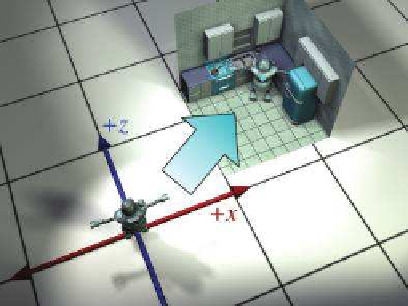Game Development Reference
In-Depth Information
surface description here; what's important is that we can move the model
around by moving its vertices around. Let's ignore for now the fact that the
robot is an articulated creature, and assume we can only move it around
in the world like a chess piece, but not animate it.
The artist who built our robot model decided (quite reasonably) to
create her at the origin of the world space. This is depicted in Figure 3.5.
Figure 3.5
The robot model was
created with the world
origin at her feet.
To simplify the rest of this example, we're going to look at things from
above. Although this is basically a 2D example, we're going to use our 3D
conventions, ignoring the y-axis for now. In this topic the convention is
for +z to point “forward” in object space and “north” in upright space,
whereas +x points “right” in object space and “east” in upright space.
Figure 3.6
Moving the model into position
For now, because the model is in its home position, object space and
world space (and upright space) are all the same by definition. For all










Search WWH ::

Custom Search